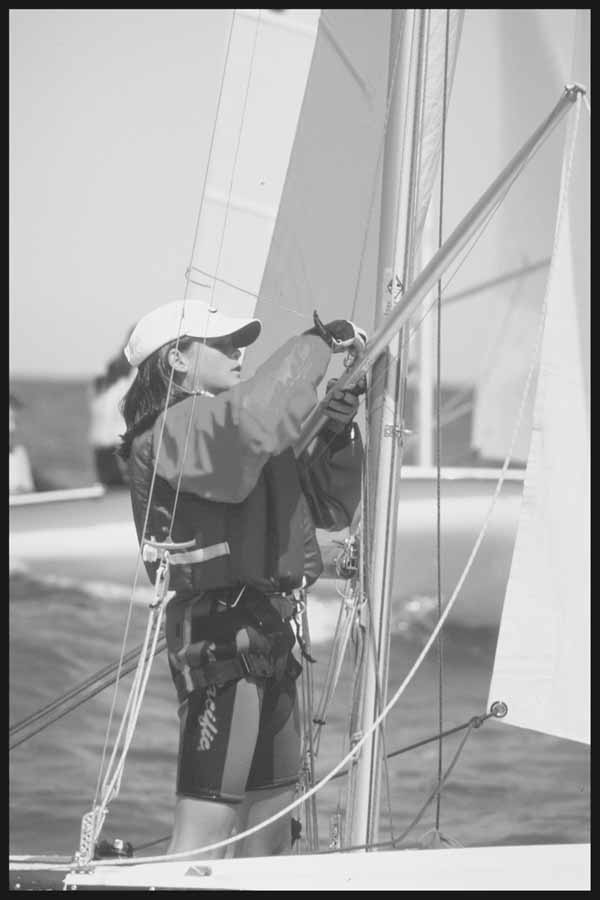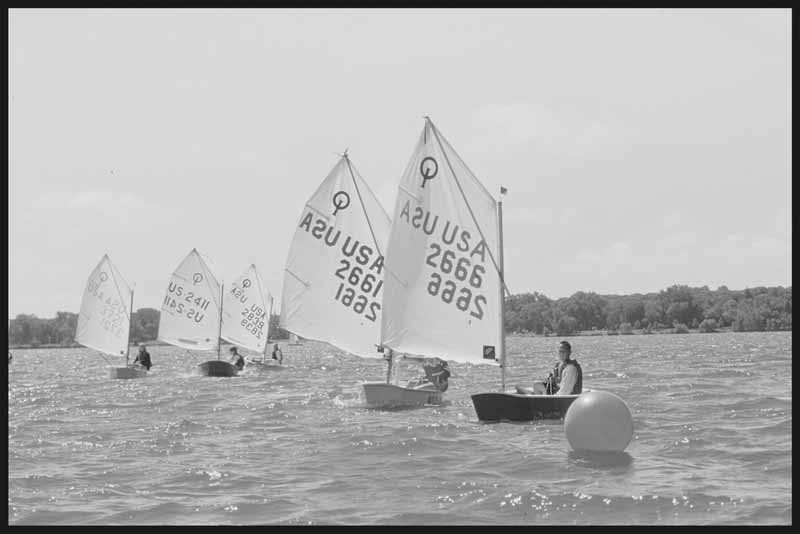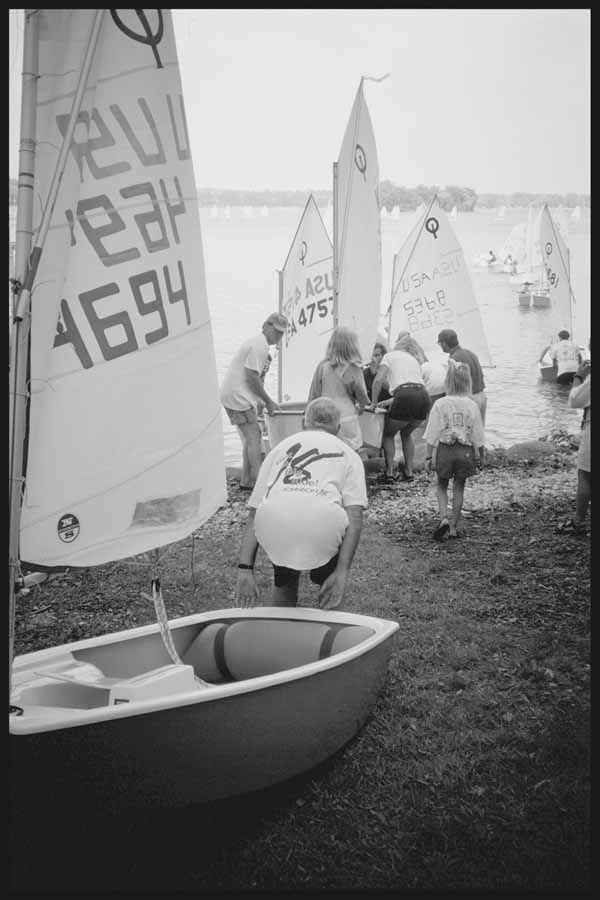
T. C. Youth Sailing
A League of Their Own
By Daniel DeWeese
 |
| T. C. Youth Sailing activities prepares young sailors for national events. This young sailor is rigging her boat for a Junior Olympics event. |
The Midwest has a rich tradition of competitive sailing that dates back to the late 1800s. Midwest lakes were the spawning and proving grounds for the earliest sleek, flat-bottomed racing scows that have come to be the darlings of competitive sailors around the world. According to Dr. Thomas A. Hodgson in his 1997 book, The History of The Inland Lake Yachting Association, the modern racing scow owes a great deal to Minnesota sailors and boat builders, in particular. When boat builders in White Bear Lake saw early scow designs, they became instrumental in their development. According to Hodgson, “White Bear Lake's involvement with scow development was natural enough. In fact, Maynard Meyer of Pewaukee later called White Bear the ‘most recognized center’ of Midwest boat building at the turn of the century.”
Minnesota sailors take pride in their sailing heritage and a group of dedicated parents are seeing to it that Minnesota’s lake racing legacy continues on into the future. T.C. Youth Sailing is an unincorporated group of parents from throughout the Twin Cities (hence, the “T.C.” in the name) who organize an informal racing season for area youngsters aged eight to 15. Pat Dunsworth, an architect and photographer who lives in Mahtomedi, MN, near White Bear Lake, is a perennial member of the T.C. Youth Sailing board of directors. He was an architect of the original version of the unaffiliated league called the T.C. Optis, and continues to be an active supporter of the program, which is now in its fifth season, and expanded to include Laser and Club-420 classes last year.
Dunsworth describes T.C. Youth Sailing as a kind of amateur sailing league designed to give sailing school students racing experience beyond their local schools. Working closely with training programs at White Bear Sailing School, Lake Calhoun Sailing School, Lake Minnetonka Sailing School, Upper Minnetonka Sailing School and the Minneapolis Aquatennial, T.C. Youth Sailing organizes five racing events each summer for Opti, Club-420 and Laser classes.
“The association really binds a lot of the sailing groups together in the Twin Cities, especially with regard to one-design sailing,” Dunsworth explains. Promoting and perpetuating one-design racing and sailing in general are key missions of T.C. Youth Sailing. The youngest kids usually learn to sail and race in Optimists, small one-person dinghies that are as easy to handle and as they are quick to learn on. “Each yacht club has a sailing school which uses Optimists and X boats as their training boats. By about 9, the kids really start showing the ability to grasp racing. By the time the kids reach the age of 16, we have a large group of very accomplished sailors.”
T.C. Optis evolved with the help of Lake Minnetonka Sailing School, which charters boats by event or per season to competing sailors in need of boats. “A family does not have to own a sailboat and they do not have to know how to sail (at Minnetonka),” Dunsworth says. “They simply send the kid and the kid learns how to race or learn how to pleasure sail. Because of this opportunity, parents in the other yacht clubs in the Twin Cities that have been affiliated with Minnetonka Sailing School over the years wanted our own kids to have the opportunity to race with the Minnetonka kids. The idea was to simply create a league where the White Bear, Calhoun and Upper Minnetonka kids could get together with the Minnetonka kids and get practice with large fleet racing.”
He says kids in smaller schools are inherently at a disadvantage when they compete in a regional race. “They need the experience of handling a large starting line with 50 or more boats,” Dunsworth says.
“When we started our kids at White Bear, we had maybe five kids starting in an Optimist race at any given time,” Dunsworth recalls. “We would go to regional events and the kids would have a difficult time coping with large fleets. When we saw the strength of the Minnetonka sailors at the regional races, we realized we had a great opportunity right here in the Twin Cities. If we could develop a league format, the kids from the smaller sailing schools could take advantage of the size and skills afforded the larger sailing school kids. The side benefit for everybody is that, aside from helping smaller sailing school kids stay competitive, their sphere of friends broadens. When they go to a regional event it’s not just them and their sailing school buddies, it’s all of their friends from the Twin Cities program that they know.”
The league idea quickly took on a life of its own, and local sailing schools of all sizes recognized potential benefits for their students, for their programs and for sailing in general. “We created the league by calling parents and enlisting volunteers,” Dunsworth says. “Then we called the sailing schools who provide coaching. Then we talked to the yacht clubs, who provided race committee equipment and venues. Between the families, the schools and the yacht clubs, everything fell into place.”
Dunsworth says the concept was for an informal racing agenda limited to a few events each summer. Each of the four affiliated sailing schools hosts one event. A fifth event is held in conjunction with the Minneapolis Aquatennial celebration.
“Our experience with youth sailing is that it’s easy for a child to become overcommitted,” Dunsworth says. “Between the Optimists and Lasers and soccer and football, it’s pretty easy to burn a kid out, so we made sure it was a flexible program.”
 |
| Young Twin Cities sailors anxiously await the start of an Optis race. |
Opti racers who want to attend every event earn points that are tallied at the end of the final race of each season. “For the Lasers and 420s, each event sort of stands on its own,” Dunsworth says. “For the Optimists, if the kids come to all of the events, their race scores are accumulated over the summer and at the end of the summer we have overall winners with awards going down to fifth to tenth place, depending on the number of kids in each class. At the end of the season, we give out about 35 awards to all of the Optimist sailors.
“The final event is always a lot of fun,” he adds. “By then, the kids who have been participating all year are very competitive and know exactly who they have to beat and are really looking forward to the awards at the end of the day.”
Dunsworth says one thing that makes Opti sailing really work for everyone is that Optimists race for not only for an overall winner, but also for each age group. The program is comprised of four fleets: The Green fleet for kids of any age who are novices; the White fleet for ages 10 and under; the Blue fleet is ages 11 to 12; the Red fleet is ages 13 to 15. It is structured this way “so the little kids are not only racing against the big kids, but against kids their own size and age,” Dunsworth says. “We give out top three awards to every age group as well as overall.”
The league expanded to include double-handed classes for older kids. “For three years, all we did was run Optimist races and had a lot of fun,” Dunsworth says. “Then we began to see that as the kids grew too old or too large for Optis, and as they passed the 16-year-old limit for racing X boats, they were running out of options, and we wanted to provide more options. The scow associations have several classes that are available to kids, but they’re run as an adult class so the kids are racing against adults. We wanted to provide a racing format where they were racing with the same kids they’d been racing with since they were eight.”
Again, Lake Minnetonka Sailing School was able to accommodate T.C. Youth Sailing’s aspirations. “Fortunately, Lake Minnetonka Sailing School is very closely tied to high school and U.S. Sailing Assn. programs,” Dunsworth says. “The boats they use are Lasers for single-handed, 420s for double-handed and various double-handed dinghies, so those are the boats we have included. Over the last two years, we have seen attendance in these high school classes increase steadily, so it’s been very rewarding to see the kids remain in sailing even if they don’t still own a boat. They can charter a boat from Minnetonka or borrow a boat and come to an event and race.”
Each event is held on a Friday when sailing schools are closed. Races start at 10:30 and conclude by 3:30. The entire program has grown steadily. Events this summer have drawn as many 78 sailors racing in 61 boats.
“At the end of each event we have an overall champion top three, a top three for each age group as well as a top three awards for Laser Radial, Laser full rig and 420. Even in the 420s we break it down to main and jib or spinnaker and trapeze. This is because some kids have not practiced on spinnaker or have only done high school sailing, which only uses main and jib. We try to give as many opportunities as we can for kids to compete head-to-head on an equal basis and learn something.”
The cost to participate in T.C. Youth Sailing is as little as $15 per event, and the fee includes lunch. Single-handed events cost $15 and double-handed events are $20. Optis from each racer’s sailing school are available for T.C. Youth Sailing events and the Minnetonka Sailing School charges $20 per event for a 420. “Each sailing school has developed a means for making Optimists available to their students,” Dunsworth says. The parents at a couple of the schools built trailers able to haul six Optis at a time. “Volunteers can bring the boats and tell the parents to bring the children to the designated yacht club. That makes it very easy for parents to get involved, especially parents who have never sailed.”
The easiest way to get involved with T.C. Youth Sailing is to sign up with one of the participating sailing schools in the Twin Cities. Anyone interested in participating in the program who has not attended one of the affiliated sailing schools is required to get written permission from one of the schools before he or she can compete.
T.C. Youth Sailing has a loosely structured board of directors made up of parents from each of the affiliated yacht clubs. “Some board members are people whose kids have gone through the program before and want to make sure that the sailing school is included in the sailing program we have.”
Dunsworth says kids in the smaller sailing schools have benefited greatly from the program. “Typically, they might only have five kids racing in Optimist or in high school sailing in any given year,” he says. “At Minnetonka, they have a huge number of kids and they have a well-organized program, which is due in large part to the director, Cappy Capper, who has always been a very strong advocate of the U.S. Sailing’s programs. The Minnetonka Sailing School board is just fantastic. Their board has some people who are very effective at creating programs that help the entire community, rather than just their yacht club members.
 |
| Parents get their feet wet helping out at a T. C. Youth Sailing event. |
“A lot of the credit goes to the sailing schools,” he says. “We’re trying to give the kids a chance to sail beyond their sailing school, but the sailing schools have done fantastic jobs in developing regional and national champions. Optimist sailors, because they’re getting exposed to better competition and fun organizations have a great future in regional and national competitions.”
Dunsworth says he is satisfied that T.C. Youth Sailing is living up to his and other parents’ objectives, especially in getting kids involved with sailing and racing one-designs. ”Some of the kids enjoy sailing because they enjoy the speed and the thrill and they end up with wind surfers and catamarans,” he says. “Some of the kids enjoy it just because it’s a lot of fun. They become the cruisers of America. All those people who are out there chartering boats or sailing in keelboats simply love the sport. We feel that because of our involvement with one-design amateur racing this gives us a format to introduce the kids to one-design racing that is fun and that will stick with them.”
The league’s format has also done a lot to introduce families to sailing for the first time. “It gives nonsailing parents a chance to get used to getting their feet wet, to get used to loading and unloading boats and going to the marine supply store,” Dunsworth explains. “They start to become sailors indirectly. So we’ve not only introduced kids to sailing, we’ve introduced whole families to sailing and we’ve introduced them to yacht clubs that have an awful lot to offer them.
Local publicity has boosted the program’s profile in the metropolitan area. T.C. Youth Sailing has been profiled on a local news program and its activities have been covered in a state magazine. “It’s really exposed us to a lot of people who weren’t aware that sailing classes are available or that there are races available to kids,” Dunsworth says.
The bottom line for the program’s success, however, goes to the parents, according to Dunsworth. “The fun part of all of this and one of the reasons why it’s worked so effectively, is that it’s parents that keep it running. Parents will always do what is best for their kids and the program that their kids are in.
“Aside from coaching and the sailing school staff, it’s the parents who do the leg work,” he says. “We’re the chauffeurs, we’re the ones there with the Band Aids and the pat on the back.”
For information about T.C. Youth Sailing, contact Pat Dunsworth at 651-426-8124.
Daniel DeWeese is a freelance writer based in Chanhassen, MN.
All photos contributed by Pat Dunsworth.